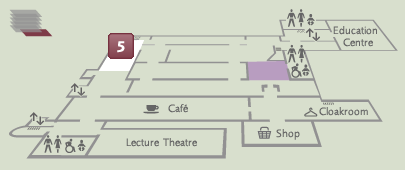Embroideries and Samplers from Islamic Egypt
A selection of 10th to 16th century embroideries from the Newberry collection at the Ashmolean by Marianne Ellis (published Oxford, 2001).

Publications online: 66 objects
- Reference URL
Actions
Textile fragment with hands and diamond-shaped medallion
-
Literature notes
The design of this motif is very intriguing but its significance remains a mystery. Its rigid hexagon shape is similar to the previous example, No.18 [EA1993.76], but instead of stepped outlines, there are little decorative hooks that can be read as hands or even little faces. As on No.18, the central pattern of V shapes is left in reserve and the background filled with blue silk in pattern darning in running stitch. The faint vertical white lines are where the worker has darned under one thread to avoid leaving long floating stitch across the ground. Judging by the fine scale of the work and its size, which is larger than the ones worked as repeating patterns, it could have been one of those arranged on either side of the neck slit of a tunic. -
Details
- Associated place
-
Near East (place of creation)
- Material and technique
- linen, embroidered with blue silk
- Dimensions
-
ground fabric 10.3 x 9.4 cm (height x width)
ground fabric 31 / 27 threads/cm (thread count)
ground fabric 0.04 cm max. (thread diameter)
ground fabric 0.01 cm min. (thread diameter)
additional fabric 0.06 cm (thread diameter)
- Material index
-
organic › animal › animal product › silk,
- Technique index
-
assembled › woven › plain woven,woven › plain woven,
- Object type index
- No. of items
- 1
- Credit line
- Presented by Professor Percy Newberry, 1941.
- Accession no.
- EA1993.90
-
Further reading
Ellis, Marianne, Embroideries and Samplers from Islamic Egypt (Oxford: Ashmolean Museum, in association with Greenville: Curious Works Press, 2001), no. 19 on p. 34, illus. p. 34
Barnes, Ruth and Marianne Ellis, ‘The Newberry Collection of Islamic Embroideries’, 4 vols, 2001, Oxford, Ashmolean Museum, cat. p. 51 (vol. iv), illus. vol. iv p. 51
Location
-
-
Lower ground floor | Room 5 | Textiles

-
Lower ground floor | Room 5 | Textiles
Objects are sometimes moved to a different location. Our object location data is usually updated on a monthly basis. Contact the Jameel Study Centre if you are planning to visit the museum to see a particular object on display, or would like to arrange an appointment to see an object in our reserve collections.
Publications online
-

Embroideries and Samplers from Islamic Egypt
The design of this motif is very intriguing but its significance remains a mystery. Its rigid hexagon shape is similar to the previous example, No.18 [EA1993.76], but instead of stepped outlines, there are little decorative hooks that can be read as hands or even little faces. As on No.18, the central pattern of V shapes is left in reserve and the background filled with blue silk in pattern darning in running stitch. The faint vertical white lines are where the worker has darned under one thread to avoid leaving long floating stitch across the ground. Judging by the fine scale of the work and its size, which is larger than the ones worked as repeating patterns, it could have been one of those arranged on either side of the neck slit of a tunic. -

The Newberry Collection of Islamic Embroideries
One diamond-shaped medallion containing rows of V-shapes and edged with hands.
Notice
Object information may not accurately reflect the actual contents of the original publication, since our online objects contain current information held in our collections database. Click on 'buy this publication' to purchase printed versions of our online publications, where available, or contact the Jameel Study Centre to arrange access to books on our collections that are now out of print.
© 2013 University of Oxford - Ashmolean Museum

